Today is Vijaya Dashami or Bijoya. Today is the day when the Goddess Durga defeated Mahisasura or the buffalo demon, after a fierce battle that lasted 9 days and 9 nights. After killing him on the 10th day, Durga came to known as Mahisasuramardini or “she who killed the buffalo demon”.
 The story of Mahisasuramardini (which you can read here or here) is perhaps one of the best known in Hindu mythology, and its associated imagery is one of the most recognisable.
The story of Mahisasuramardini (which you can read here or here) is perhaps one of the best known in Hindu mythology, and its associated imagery is one of the most recognisable.
I was introduced to the story of Mahisasuramardini by my grandmothers, and also my mother’s recitation of the Mahisasuramardini Stotram. Like most children of the 1970s, I was introduced to the popular imagery of Mahisasuramardini through Amar Chitra Katha’s “Tales of Durga” (see picture on the left).
It was this image of Mahisasuramardini that stayed with me till 1997 when I visited Mahabalipuram. I saw Indian sculptural art in a ‘natural’ setting for the first time, including this depiction of Mahisasuramardini. That was when I realised the immensity, beauty and power of the narratives I had heard and read from the time I was a kid.
That visit also marked the beginning of my interest in Hindu mythology expanding to include its representation in classical Indian art. And Mahisasuramardini fascinated me like no other, which, thanks to my travels in India, I came across in Aihole, Ellora, Patan, Vadnagar and Nalla Sopara. Artiistically and stylistically, each one of the relief sculptures were very different, and yet unmistakably that of Mahisasuramardini.
AIHOLE: This 12-armed Mahisasuramardini, with her lion mount and Mahisa in the form of a buffalo is located in the Durg Temple. The temple and the relief is believed to have been built around mid-8th century CE.
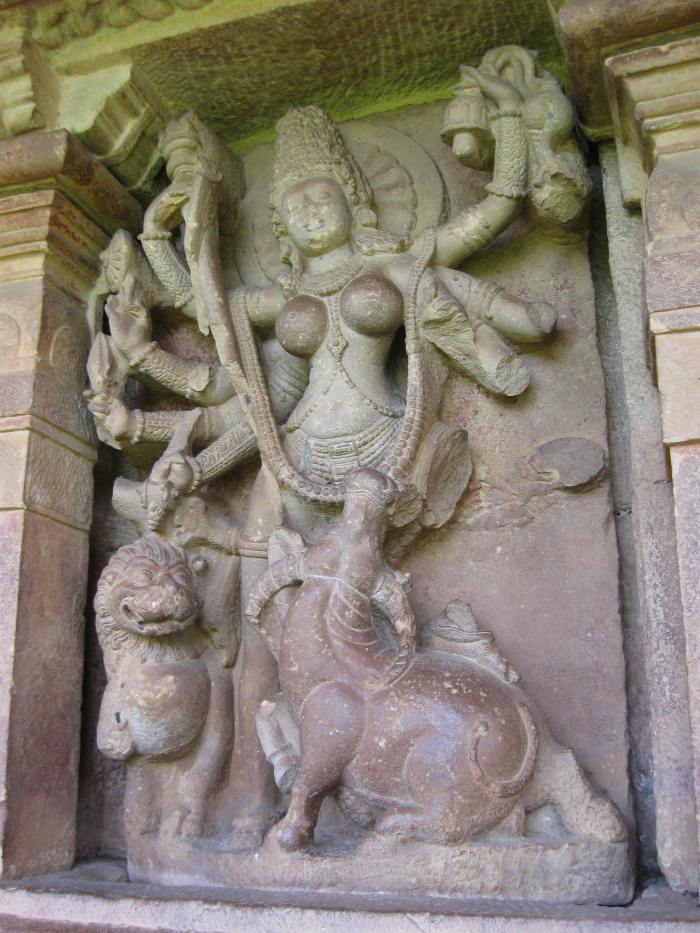
ELLORA: There are quite a few panels of Mahisasuramardini in the rock-cut cave temples at Ellora and each one is different. Only one depicts an 8-armed Durga in battle with Mahisa, who is in an anthrotheriomorphic form, or a buffalo-human hybrid form. This is my favourite panel for the sheer dynamism and energy this panel, probably from the mid-7th century CE, depicts.
The other panels are with 4-armed Durga having vanquished Mahisasura and become Mahisasuramardini. She is standing over the buffalo form of Mahisa with her right foot on his hindquarters, a weapon (trident or sword) held aloft as a sign of victory. In only one panel is her lion mount present and is busy biting into the buffalo’s flesh. All these panels are older and date from the late 8th century CE.
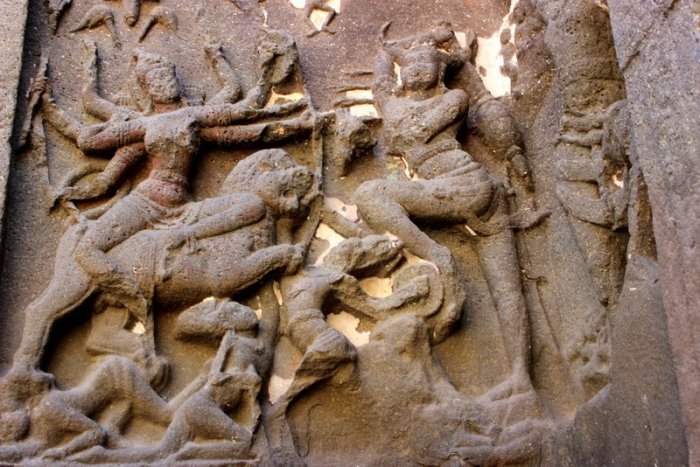

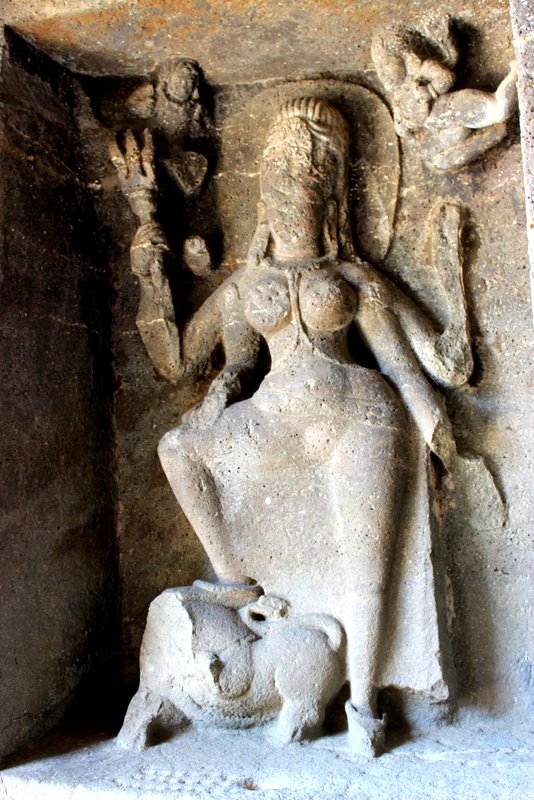
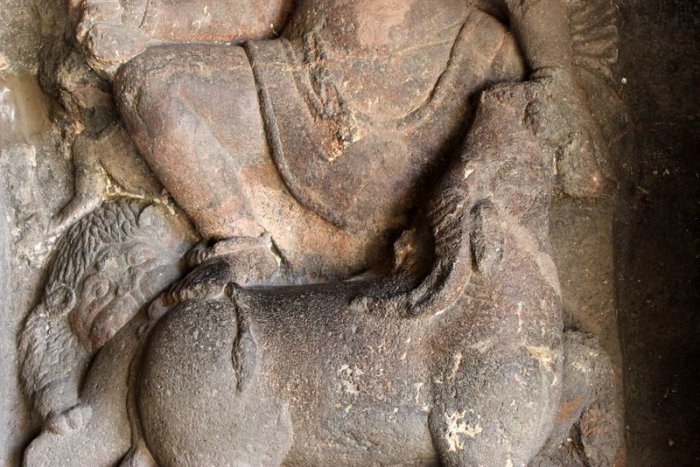 PATAN: The Mahisasuramardini at the Rani ni Vav or queen’s stepwell has 16 arms and is the most stylistic depiction of this icon. Every hand holds a weapon, except one which is pulling out Mahisasura by the hair from the decapacitated buffalo form. While this Mahisasuramardini (which dates to the 11th century CE) is a beautiful sculpture, it seems very posed not unlike a shikari with his tiger kill !
PATAN: The Mahisasuramardini at the Rani ni Vav or queen’s stepwell has 16 arms and is the most stylistic depiction of this icon. Every hand holds a weapon, except one which is pulling out Mahisasura by the hair from the decapacitated buffalo form. While this Mahisasuramardini (which dates to the 11th century CE) is a beautiful sculpture, it seems very posed not unlike a shikari with his tiger kill !
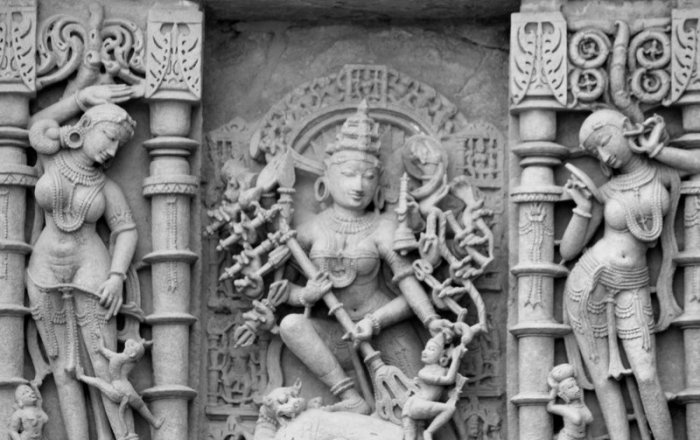
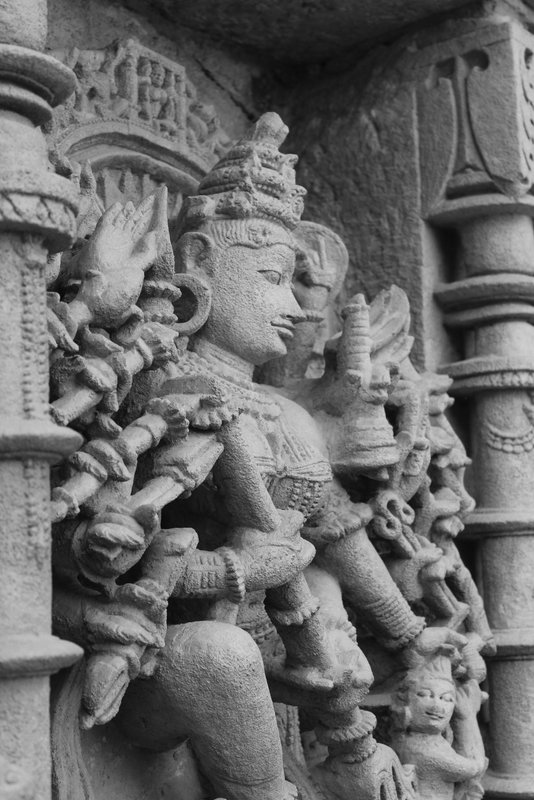 VADNAGAR: The Arjun Bari gate in the city of Vadnagar in North Gujarat has a small icon of a 4-armed Mahisasuramardini installed in a niche on the gate. Here too, the goddess is pulling out Mahisa by the hair the bullock’s neck, even as its severed neck lies on the ground. The lion-mount is attacking the bullock’s hindquarters.
VADNAGAR: The Arjun Bari gate in the city of Vadnagar in North Gujarat has a small icon of a 4-armed Mahisasuramardini installed in a niche on the gate. Here too, the goddess is pulling out Mahisa by the hair the bullock’s neck, even as its severed neck lies on the ground. The lion-mount is attacking the bullock’s hindquarters.
If you ignore the garish orange and silver paint on the sculpture, you can see that it is not very ornamented. Perhaps this Mahisasuramardini was from an earlier temple and installed when the gates were built. It certainly looks older and different from the heavily ornamented style prevalent in the area, which dates to the 11th century.
 NALA SOPARA: This Mahisuramardini is placed in a niche in a Rama temple at the Chakreshwar Mahadev Temple complex. Here the goddess has four arms and her hands hold a trident, a sword and a shield. Her fourth hand is pulling out Mahisa by his hair from his buffalo form even as he appears to grimace. The expression on this Mahisasuramardini’s face is one of calm, almost zen-like countenance as she prepares the final strike with her sword that will kill the buffalo demon. The red kumkum adds that realistic touch of blood. Though it is not clear in the picture, her lion-mount is positioned just behind her right leg.
NALA SOPARA: This Mahisuramardini is placed in a niche in a Rama temple at the Chakreshwar Mahadev Temple complex. Here the goddess has four arms and her hands hold a trident, a sword and a shield. Her fourth hand is pulling out Mahisa by his hair from his buffalo form even as he appears to grimace. The expression on this Mahisasuramardini’s face is one of calm, almost zen-like countenance as she prepares the final strike with her sword that will kill the buffalo demon. The red kumkum adds that realistic touch of blood. Though it is not clear in the picture, her lion-mount is positioned just behind her right leg.
I love this Mahisasuramardini (c. 9th century CE) as the shilpin or sculptor has captured that exact moment perfectly.
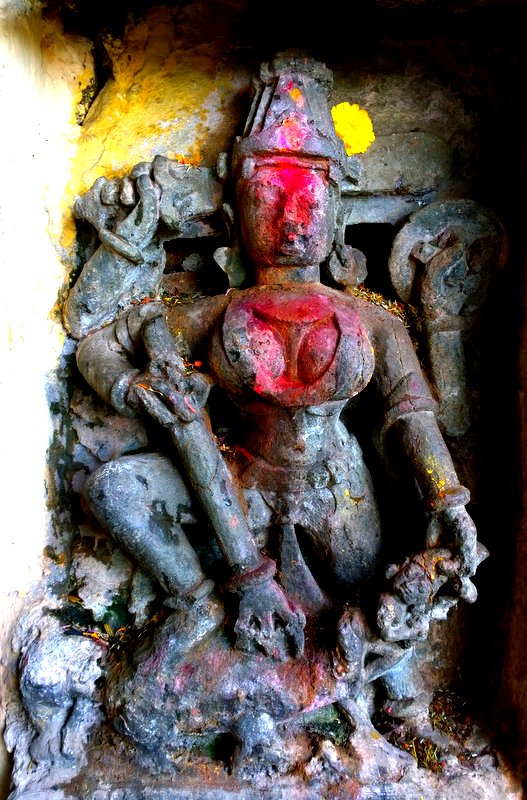
In July, I took my interest in classical Indian art beyond travel and reading. I enrolled for a year-long PG Diploma programme in Indian Aesthetics and it has turned out to be one of the best decisions I have taken in recent times. One the very first day, we were introduced to the key objectives of the programme, one of which was is to go beyond the literal “what” in classical Indian art and seek the “how” and “why”.
And slowly, very slowly, that is what I have begun to do, beginning with Mahisasuramardini.
How did the iconography of Durga as Mahisasuramardini develop?
Why did She transition from a four-armed to 12-armed divinity?
Was Durga a powerful folk deity who got incorporated into the Vedic pantheon of gods? Was the killing of Mahisa a simple animal sacrifice ritual to the local goddess that expanded to become the killing of a buffalo demon?
How did the annual Durga Puja begin?
Mahisasuramardini icon is supposed to symbolise the victory of good over evil. Did it all always symbolise this or has it changed over the centuries?
I find the ‘good over evil’ symbolism of Mahisasuramardini very simplistic and clichéd, and prefer my interpretation of the symbolism, that of overcoming ignorance and opening up one’s mind to knowledge, learning and questions.
And it is kind of perfect, for Vijaya Dashami is an auspicious day and the day of new beginnings ! For me, writing this post has been the first step towards setting the context and articulating the questions I have on Mahisasuramardini. The next step is now to seek those answers actively.
Greetings on Vijaya Dashami 🙂

Totally appreciate your talent for curation and this was an excellent post. So interesting to see myriad depictions of the same theme, that too such a powerful one!
LikeLiked by 1 person
Thank you very much, Mukta. This type of a post was a first for me and I’m looking forward to doing more along these lines. I only have the diploma programme in Indian Aesthetics to thank for making me look at an an icon like Mahisasuramardini in such a different way.
I think that if I were to ever consider doing a Ph.D. Mahisasuramardini will be a very close contender as a topic. 😉
LikeLiked by 1 person
Very informative and interesting post.
LikeLiked by 1 person
Thank you very much, Lata. I hope to bring out more of such posts, 😉
LikeLiked by 1 person
Only you can write a beautiful post of the Goddess. I have always seen Durga depicted with ten hands sitting atop a lion and slaying the buffalo demon with her trident signifying victory over evil — a theme that I think runs across all major religious scriptures.
Yes, most of the Goddesses portrayed in Calcutta pandals had serene faces – a point we often wondered about as children. While the Ahiole sculpture is beautiful, the orange painted Durga at Vadnagar is quite fierce.
LikeLiked by 1 person
Thank you, Neena. While I have come across angry aspects of Shiva and Kali, I have never come across a fierce Mahisasuramardini. It is the benign, almost zen-like version that appears to be the most popular.
The Vadnagar Mahisasuramardini is a paint job, gone wrong !
LikeLike
Thanks to share the importance of goddess Durga. Today I know, why we celebrate the Durga Pooja.
LikeLiked by 1 person
A warm welcome here, Nutan. Thank you for stopping by and commenting, and glad that you found the post useful. 🙂
LikeLike